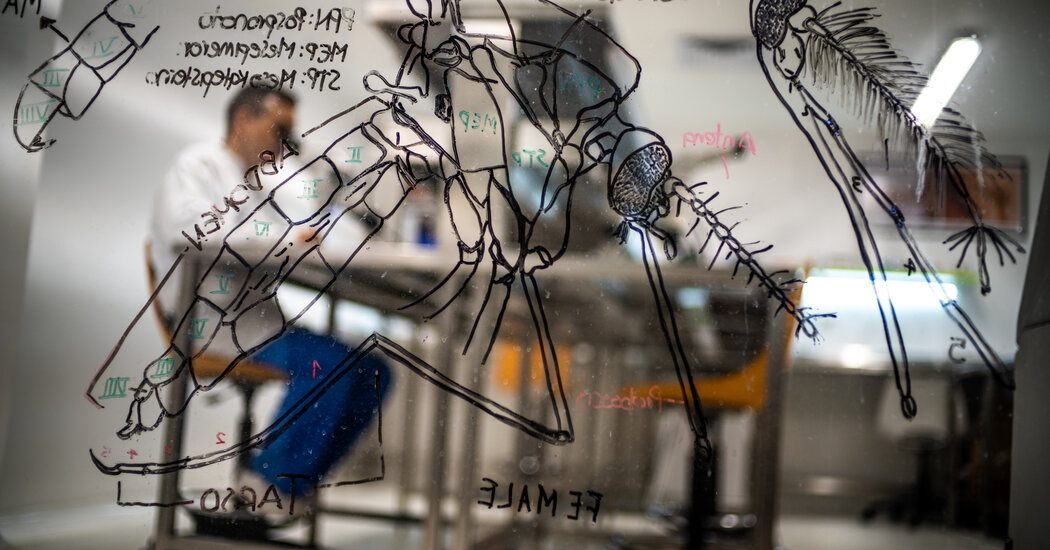Times Insider explains who we are and what we do and delivers behind-the-scenes insights into how our journalism comes together.
In one corner of the low-roofed shed, a cluster of mosquitoes, most likely carrying malaria, rested on a wall. In the opposite corner, a herd of goats — who seemed displeased to see me — huddled together. I crouched on the dirt between the two parties, trying to offend neither, taking notes.
It was June 2023, and I was tagging along as Dejene Getachew, an Ethiopian entomologist, hunted for Anopheles stephensi, an invasive species of mosquito that threatens African cities with malaria. He was giving me a tour of the most glamorous spots in Dire Dawa, Ethiopia’s second-largest city. After visiting the shed, we picked our way up algae-coated drainage canals and ran a dipper — a plastic scooper with a long handle — through sewage ponds, searching for larvae amid what Dr. Getachew elegantly referred to as “organic matter.”
Those were just a few of my adventures during a year of reporting on mosquitoes for The New York Times. I began my journey in September 2022; last month, after six countries, 32 flights and countless hours on bone-jarring dirt roads, I finally finished my six-part series.
When I embarked on my reporting, I did not anticipate ending up in a sewage pond. Working under the happy belief that humans were edging into the lead in their fight against mosquitoes, I intended to tell a straightforward story about innovative technologies that prevented the spread of malaria. But a few conversations with researchers taught me that as fast as humans had developed mosquito solutions, mosquitoes had evolved to evade them. Most insecticides don’t work well anymore. Malaria cases and deaths, which had fallen to historic lows in 2015, are climbing again: The disease killed 620,000 people, mostly children, in 2021, according to the World Health Organization.
To understand what is happening, and what we can do about it, I had to get on the road.
In the Tanzanian town of Ifakara, I visited Mosquito City, a research site run by the Ifakara Health Institute. To get there, I had to wade across an unexpected swamp — Ifakara is regularly flooded by heavy rains. Lina Finda, the researcher conducting my tour, didn’t hesitate: She tucked her stylish shoes under her arm, took my hand and plunged in.
The facility has huge mesh cages that house model villages; inside them, scientists test mosquito control methods on volunteers. Each cage has a replica home, a banana tree, old car tires, plastic buckets and cows, just like you might find in a real community.
At the institute, as with many places I visited, the research is conducted by Africans, many of them young women — a significant change from when I started covering public health on the continent 25 years ago, when the work was mostly led by American and European men.
Dr. Finda and a few of her graduate students also took me on a series of village visits so that I could better understand a question they were exploring: What would it cost to help people in the most malaria-affected areas make basic improvements to their homes?
We walked down dirt pathways, on the hunt for the right houses and families to tell this story. I started to feel like some sort of infectious-disease-obsessed real estate agent. Two families let the photographer Esther Ruth Mbabazi and me crawl around their bedrooms to understand how their homes were built.
In Medellín, Colombia, I spent a damp day in a so-called mosquito factory with the photographer Federico Rios Escobar. A team there infects mosquitoes with a bacteria called Wolbachia, which prevents the insects from transmitting dangerous diseases, such as dengue fever. At the factory, technicians rear more than 100 million mosquitoes a week, to disperse in cities, ideally spreading the bacteria to other mosquitoes. We hunched over tubs of larvae about to transition to adulthood, hoping to capture the moment one emerged from the water and took flight.
Reporting the last part of the series took me somewhere I’d never been: the tiny African nation of São Tomé and Príncipe. There, a team from the University of California, Davis, has partnered with local researchers in an effort to use genetically modified mosquitoes to block malaria-carrying species from spreading the disease.
We drove out of the city one night to visit volunteers in tiny villages in the rainforest. They were performing “human landing captures”: sitting outside with their legs exposed, waiting to feel the tickle of a mosquito before sucking it into a glass tube and depositing it in a sealed cup for later study.
I asked people in São Tomé and Príncipe how they felt about their country potentially being one of the first to experiment with genetically modified mosquitoes. Over and over again, people told me that while the unknowns made them nervous, they knew what it was like to live with malaria. They recalled falling ill when they were young. They told me about siblings who had died of the disease. To protect their children, they said, they were willing to take risks.
It was a stark reminder of the critical importance of all this research. Because right now, as Eric Ochomo, an entomologist in Kenya, told me, “the mosquitoes are winning.”











